Use of Flat Interwoven Wooden Strips in Architecture and Construction. Simulation and Optimization Using 3D Digital Models
Abstract
1. Introduction
2. Reference Architectural Works Built with Interwoven Wooden Elements
3. Evolution of Traditional Basketry Wefts and Geometries with 3D Digital Modeling
4. Materials and Methods
4.1. Method
4.2. Documentary Analysis. Qualitative and Quantitative Aspects
4.3. Samples and Material
4.4. Tests
4.4.1. Tensile Strength
4.4.2. Flexibility and Curvature Tests
4.5. 3D Model-Based Solution
5. Results and Discussion
5.1. Tests
5.1.1. Tensile Strength
- Apparent density at 12% humidity: 590 kg/m3, medium light
- Volumetric contraction coefficient: 0.39%
- Hardness (Chaláis-Meudon): 2.5 semi-soft
- Tendency to curve: Small. Persistent wood.
- Flexural strength: 710 kg/cm2
- Resistance to compression: 460 kg/cm2
- Tensile strength: 1280 kg/cm2
- Modulus of elasticity: 100,000 kg/cm2
5.1.2. Flexibility and Curvature Tests
5.2. 3D Models
6. Conclusions
Author Contributions
Funding
Institutional Review Board Statement
Informed Consent Statement
Data Availability Statement
Conflicts of Interest
References
- European Commission. European Construction Sector Observatory. 2020. Available online: http://ec.europa.eu/growth/sectors/construction_en (accessed on 30 April 2021).
- Mudgal, S.; Tan, A.; Pahal, S.; Stefan, S.; Brückner, M. Sectoral Resource Maps; European Commission, DG Environment: Brussels, Belgium, 2013; p. 62. [Google Scholar]
- Gamero, E.; Ruiz-Roso, M.; Trinidad, M.; García, R.; Cuéllar, S. Utilización de materiales naturales y reciclados para alcanzar edificios de energía casi nula. Proyecto Life Renatural NZEB. In Proceedings of the CIES2020-XVII Congresso Ibérico e XIII Congresso Ibero-Americano de Energía Solar, LNEG-Laboratório Nacional de Energia e Geologia, Lisbon, Portugal, 3–5 November 2020; pp. 1087–1090. [Google Scholar]
- Fernando, V.; Camilla, M. 0 Km Conservation. In Vernacular Architecture. Towards a Sustainable Future; Mileto, C., Vegas, F., García, L., Cristini, V., Eds.; CRC-Balkema: London, UK, 2014; pp. 737–740. [Google Scholar]
- Adovasio, J. Fifty years with baskets. N. Am. Archaeol. 2021, 42, 119–139. [Google Scholar] [CrossRef]
- Pallasmaa, J. Animales Arquitectos; Gustavo Gili: Barcelona, Spain, 2020. [Google Scholar]
- Ezquerra, A.; Gorbea, M. Caserío Igartubeiti (Ezkio-Itsaso). Arkeoikuska Inves. Arq. 1995, 1995, 460–468. [Google Scholar]
- Ban, S. Paper Log Houses, Cebu, Philippines. 2014. Available online: https://arquitecturaviva.com/works/cabinas-de-papel-1 (accessed on 30 April 2021).
- Miralles, E.; Tagliabue, B. Spanish Pavilion for World Expo Shangai 2010. Available online: http://www.mirallestagliabue.com/project/spanish-pavilion-for-world-expo-shanghai-2010/ (accessed on 30 April 2021).
- Ban, S. Hospital Daycare Center in Odate Japan. 2001. Available online: http://www.shigerubanarchitects.com/works/2001_imai_hospital_daycare_center/index.html (accessed on 30 April 2021).
- Ban, S. Aspen Museum, Colorado, USA. 2014. Available online: http://www.shigerubanarchitects.com/works/2014_aspen-art-museum/index.html (accessed on 30 April 2021).
- Ban, S. Centre Pompidou Metz, France. 2010. Available online: http://www.shigerubanarchitects.com/works/2010_centre-pompidou-metz/index.html (accessed on 30 April 2021).
- Aalto, A. Armchair 45 with Cane Seat. 1947. Available online: https://www.alvaraalto.fi/en/work/armchair-45/ (accessed on 30 April 2021).
- Irazoki, J.L.; Lizaso, A. Zumitz, Alki. 2016. Available online: http://alki.fr/fr/produit/7219/Zumitz/ (accessed on 30 April 2021).
- Fernández, S.; González, P.; Mozo, A. Informe Sobre la Estabilidad de las Bóvedas y el Sistema de Contrarresto de la Nave y el Crucero de la Iglesia de La Peregrina (Convento de San Francisco) en Sahagún; Ayuntamiento de Sahagún: Trycsa, Madrid, Spain, 2010. [Google Scholar]
- Upphapong, B.; Champadaeng, S.; Sookna, S. The development of bamboo basketry according to the base of creative economy of the Thai Yo Ethnic group in Northeast Thailand. Asian Soc. Sci. 2013, 9, 231. [Google Scholar] [CrossRef]
- Van Aken, J. Management Research Based on the Paradigm of the Design Sciences: The Quest for Field-Tested and Grounded Technological Rules. J. Manag. Stud. 2004, 41, 219–246. [Google Scholar] [CrossRef]
- Holmström, J.; Ketokivi, M.; Hameri, A.P. Bridging practice and theory: A design science approach. Decis. Sci. 2009, 40, 65–87. [Google Scholar] [CrossRef]
- Simon, H. The Sciences of the Artificial; Comares: Granada, Spain, 2006. [Google Scholar]
- Gregor, S.; Hevner, A. Positioning and presenting design science research for maximum impact. MIS Quart. 2013, 337–355. [Google Scholar] [CrossRef]
- Jones, D.; Gregor, S. The anatomy of a design theory. J. Assoc. Inform. Syst. 2007, 8, 1. [Google Scholar] [CrossRef]
- March, S.; Smith, G. Design and natural science research on information technology. Decis. Supp. Syst. 1995, 15, 251–266. [Google Scholar] [CrossRef]
- Hevner, A.; March, S.; Park, J.; Ram, S. Design science in information systems research. MIS Quart. 2004, 28, 75–105. [Google Scholar] [CrossRef]
- Peffers, K.; Tuunanen, T.; Rothenberger, M.A.; Chatterjee, S. A design science research methodology for information systems research. J. Manag. Inform. Syst. 2007, 24, 45–77. [Google Scholar] [CrossRef]
- Guillaud, S.; Vermeulen, C. Basketry in Madagascar’s protected areas: Issues and consequences. Bois For. Trop. 2014, 320, 43–57. [Google Scholar] [CrossRef]
- Wendrich, W.; Holdaway, S. Basket use, raw materials and arguments on early and Middle Holocene mobility in the Fayum, Egypt. Quatern. Internat. 2018, 468, 240–249. [Google Scholar] [CrossRef]
- Jolie, E. The technomechanics of plains Indian coiled gambling baskets. Plains Anthrop. 2006, 51, 17–49. [Google Scholar] [CrossRef]
- Gailiunas, P. Mad weave. J. Math. Arts 2017, 11, 40–58. [Google Scholar] [CrossRef]
- Rosengarten, D. By the rivers of Babylon: The Lowcountry basket in slavery and freedom. In African Ethnobotany in the Americas; Springer: New York, NY, USA, 2013; pp. 123–152. [Google Scholar]
- Anderson, M. The fire, pruning, and coppice management of temperate ecosystems for basketry material by California Indian tribes. Hum. Ecol. 1999, 27, 79–113. [Google Scholar] [CrossRef]
- Camp, A. Catlow Twine basketry in the western Great Basin: Use and reuse in the archaeological record. Quat. Intern. 2018, 466, 318–323. [Google Scholar] [CrossRef]
- Lake, F.; Marks-Block, T. Effects of understory fire management treatments on California hazelnut, and ecocultural resource of the Karuk and Yurok Indians in the Pacific Northwest. In Proceedings of the 2020 ESA Annual Meeting, Online, 3–6 August 2020. [Google Scholar]
- Caputo, A. Entretejidos ye’kuana: Oralidad, mito, artesanía. Antíp. Rev. Antrop. Arq. 2018, 31, 109–130. [Google Scholar] [CrossRef]
- Martínez, M. Los diseños en la cestería seri. Ensayo sobre técnicas de vinculación social. An. Inst. Investig. Estéticas 2016, 38, 135–170. [Google Scholar] [CrossRef]
- Bunn, S. Basket-work, well-being and recovery: The story from Scotland. Craft Res. 2020, 11, 39–56. [Google Scholar] [CrossRef]
- Kvavadze, E.; Bar-Yosef, O.; Belfer-Cohen, A.; Boaretto, E.; Jakeli, N.; Matskevich, Z.; Meshveliani, T. 30,000-year-old wild flax fibers. Science 2009, 325, 1359. [Google Scholar] [CrossRef]
- Nadel, D.; Werker, E. The oldest ever brush hut plant remains from Ohalo II, Jordan Valley, Israel (19,000 BP). Antiquity 1999, 73, 755. [Google Scholar] [CrossRef]
- di Lernia, S.; N’siala, I.; Mercuri, A. Saharan prehistoric basketry. Archaeological and archaeobotanical analysis of the early-middle Holocene assemblage from Takarkori (Acacus Mts., SW Libya). J. Arch. Sci. 2012, 39, 1837–1853. [Google Scholar] [CrossRef]
- Quesada, C.; Rodes, C.; Fernández, A.; Mathias, F. La cestería decorada de la Cueva de los Murciélagos (Albuñol, Granada). Complutum 1996, 6, 105–122. [Google Scholar]
- Herrero, M.; Romero, S.; Huerta, R. Plants used in basketry production during the Early Neolithic in the north-eastern Iberian Peninsula. Veget. Hist. Arch. 2021, 1–14. [Google Scholar] [CrossRef]
- Romero, S.; Huerta, R.; Herrero, M. The basketry at the early Neolithic site of La Draga (Banyoles, Spain). J. Arch. Sci. Rep. 2021, 35, 102692. [Google Scholar]
- Xabier, A. La cesteria del castaño en Duralgaldea. Juan Unzueta; Arbaso: Durango, Spain, 1998. [Google Scholar]
- Anderson, M. Indian Fire-Based Management in the Sequoia-Mixed Conifer Forests of the Central and Southern Sierra Nevada. Final Report to the Josemite Research Center, Yosemite National Park, United States Department of Interior, National Park Service, Western Region; Cooperative Agreement Order Number 8027–002; University of California Berkeley: Berkeley, CA, USA, 1993. [Google Scholar]
- Fontales, C. Mas que Cestos. Cestería Española; Rotura: Madrid, Spain, 2013. [Google Scholar]
- Herrera, J.; Rojo, Ú.; Parra, S.; López, C. Efecto de la temperatura de procesado sobre las propiedades mecánicas de tableros aglomerados sin resina sintética. Prospectiva 2011, 9, 75–80. [Google Scholar]
- De Campos, C.; Rocco, F. Caracterizaccion del MDF producido a partir de Eucalipto y adhesivo Poliuretano natural. Mad. Cienc. Tec. 2004, 6, 73–84. [Google Scholar] [CrossRef]
- Rangel, L.; Moreno, P.; Trejo, S.; Valero, S. Propiedades de tableros aglomerados de partículas fabricados con madera de Eucalyptus urophylla. Mad. Cienc. Tec. 2017, 19, 373–386. [Google Scholar] [CrossRef]
- Plubins, N. Parametrización del Curvado de Vara de Mimbre Blanco Maduro. End of Degree Work. Bachelor’s Thesis, Faculty of Architecture and Urbanism, Santiago, Chile, October 2015. [Google Scholar]
- Rodríguez, R. Caracterización de las Propiedades Mecánicas del Bambú (Bambusa Vulgaris). Civil Eng. 2018. Available online: http://hdl.handle.net/20.500.12475/352 (accessed on 30 April 2021).
- Tomilova, M.; Smirnova, Н.; Lapshin, B. The ability of materials to plaiting. Kostroma State Technol. Univ. 2013, 3, 17. [Google Scholar]
- Muscio, E.; Anaya, J. Study of the permissible bending radius of bamboo cuts. Experimental analysis with Phyllostachys bambusoides Sieb. et Zucc. Anales Edific. 2018, 4, 10–17. [Google Scholar]
- Kovács, F. Number and twistedness of strands in weavings on regular convex polyhedra. Math. Phys. Eng. Sci. 2014, 470, 20130608. [Google Scholar] [CrossRef] [PubMed]
- Sketchfab. Available online: https://sketchfab.com/search?q=basketry&sort_by=-relevance&type=models (accessed on 30 April 2021).
- Dellosa, S.; Salvador, F. Representation of basket constructs using braid theory. In Proceedings of the 4th international conference on Computer graphics and interactive techniques in Australasia and Southeast Asia, Kuala Lumpur, Malaysia, 29 November–2 December 2006; pp. 443–451. [Google Scholar]
- Centro de Innovación para la Formación Profesional. Manual Técnico de Formación para la Caracterización de Madera de uso Estructural. Departamento de educación Política Lingüística y Cultura Gobierno Vasco, Tknika. 2004. Available online: https://normadera.tknika.eus/es/content/ficha/casta%C3%B1o.html (accessed on 30 April 2021).
- Torrado, A.; Roberson, D. Failure analysis and anisotropy evaluation of 3D-printed tensile test specimens of different geometries and print raster patterns. J. Fail. Anal. Prev. 2016, 16, 154–164. [Google Scholar] [CrossRef]

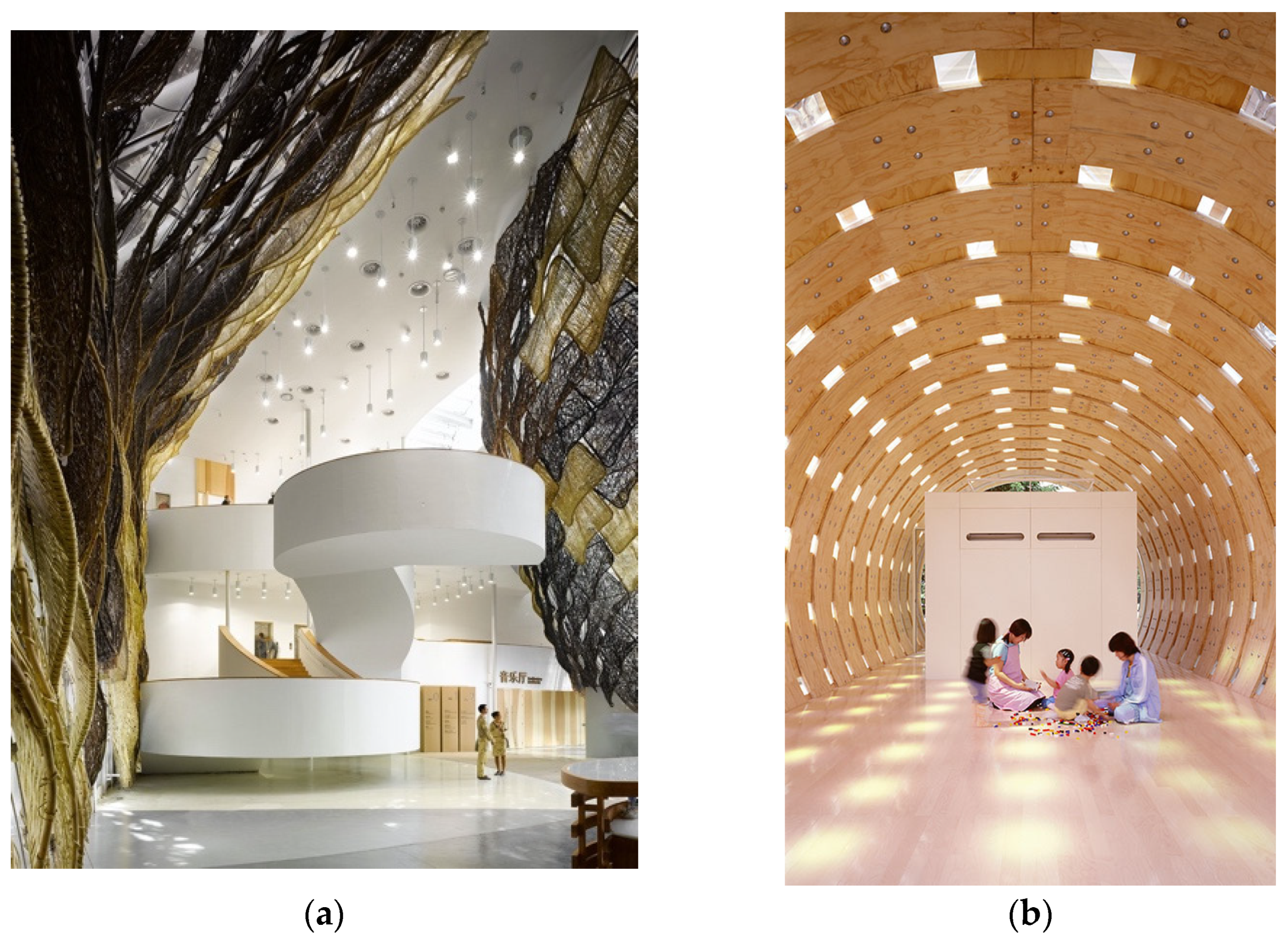
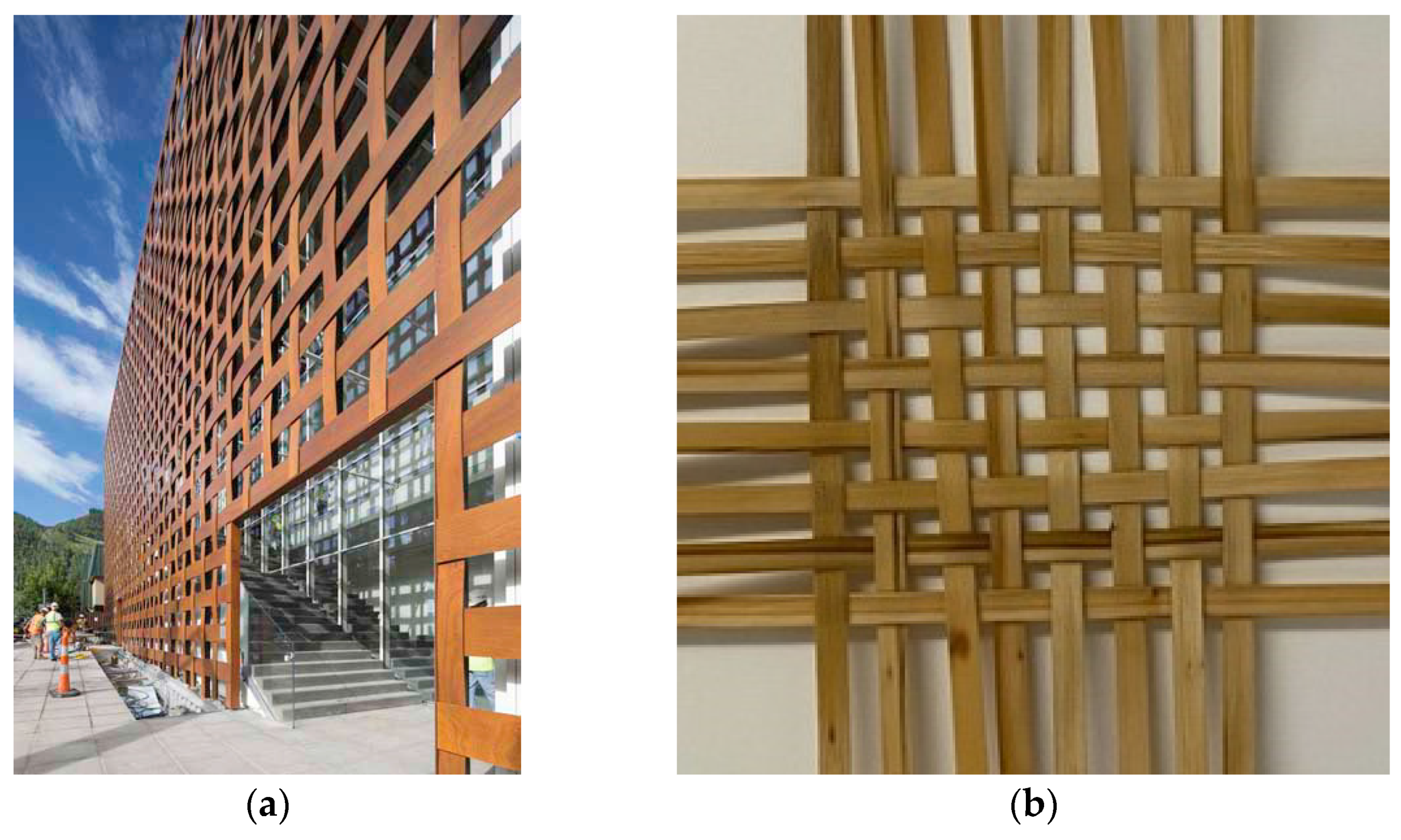

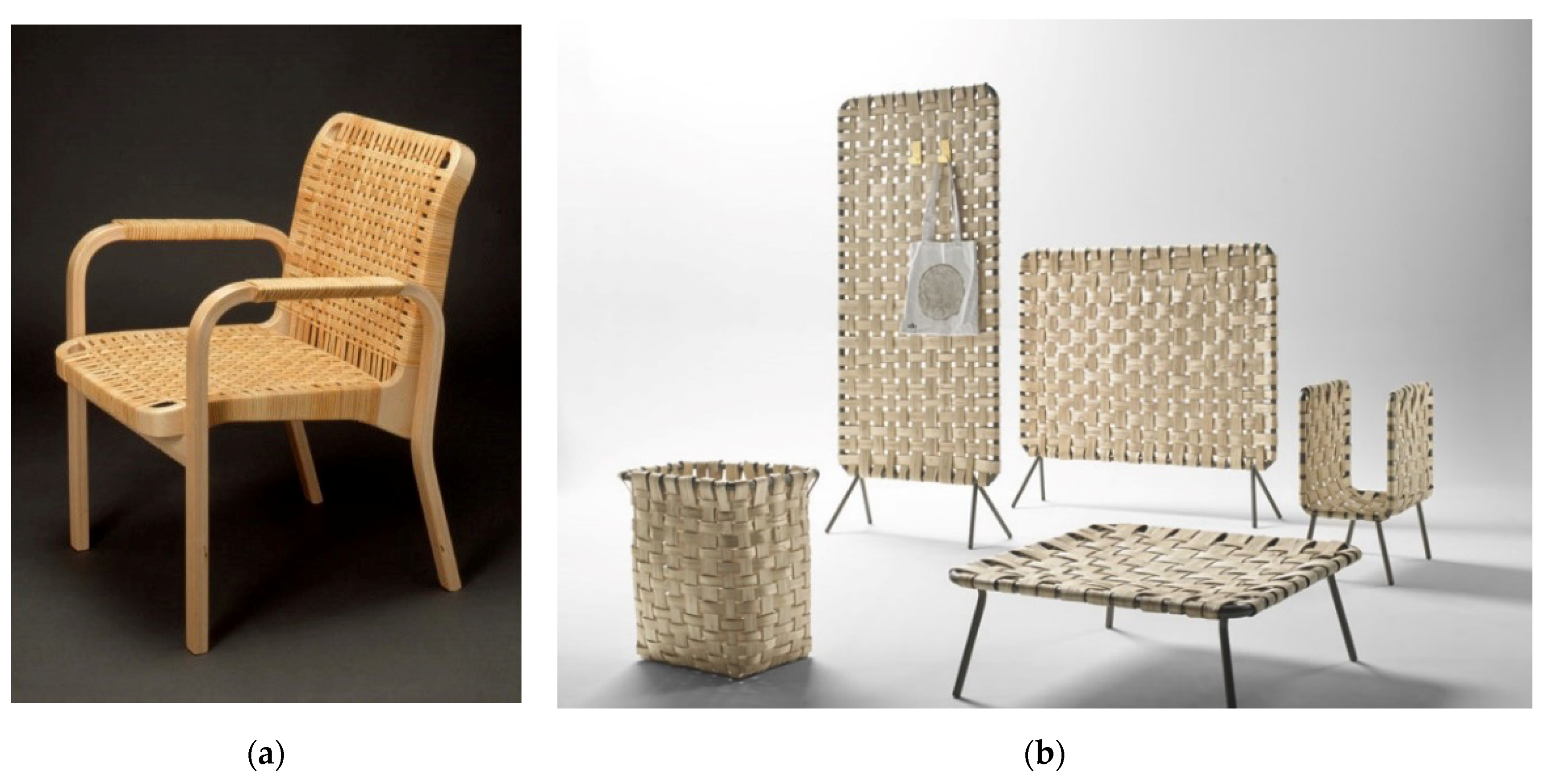
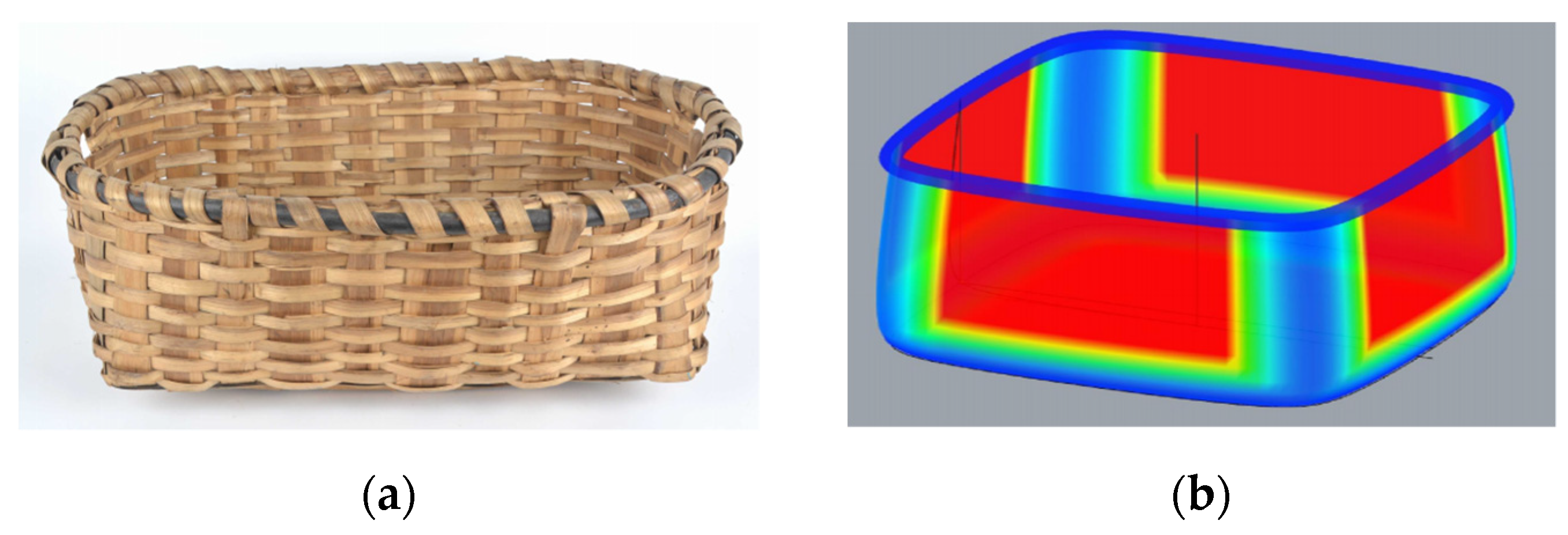
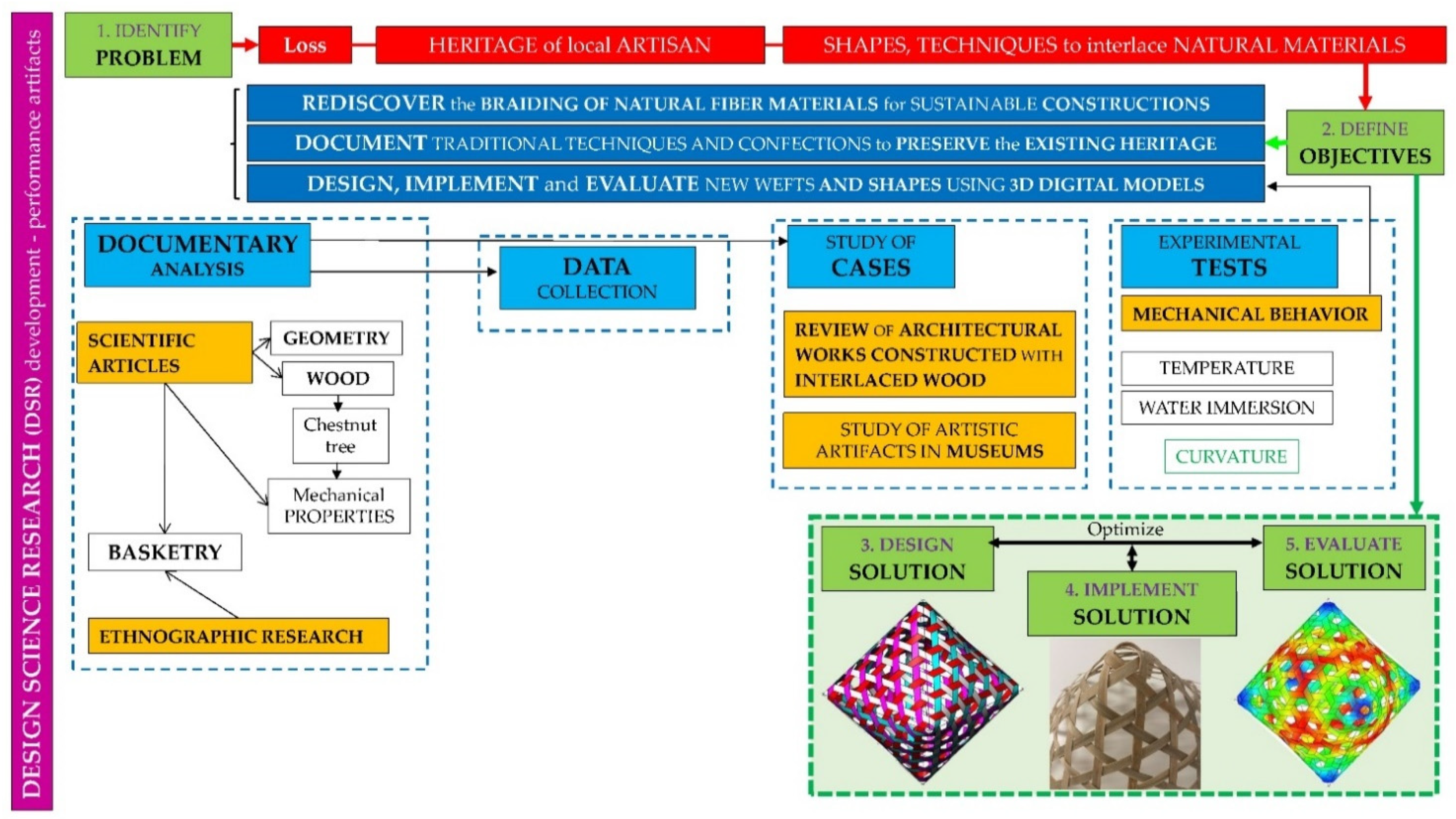


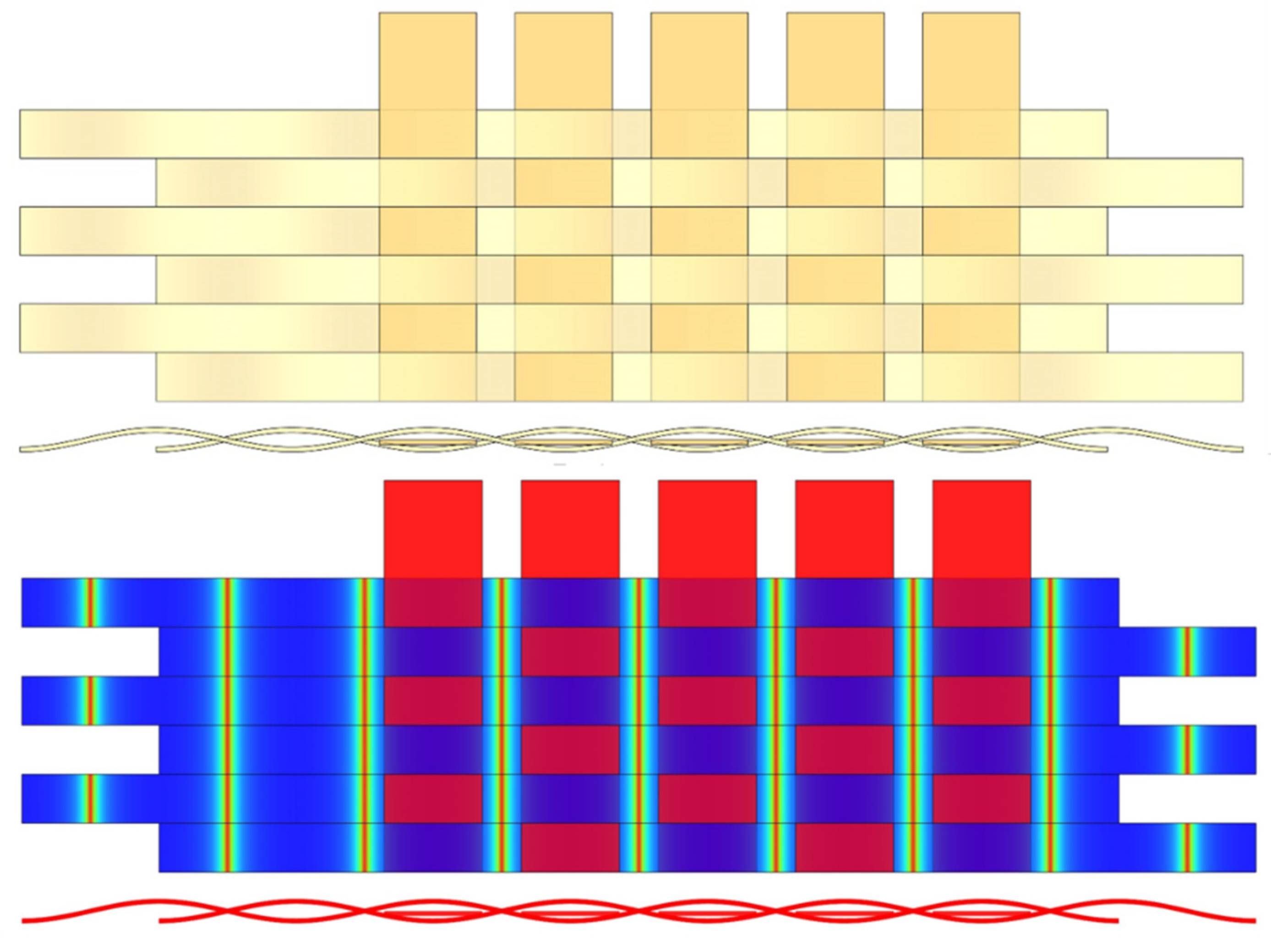



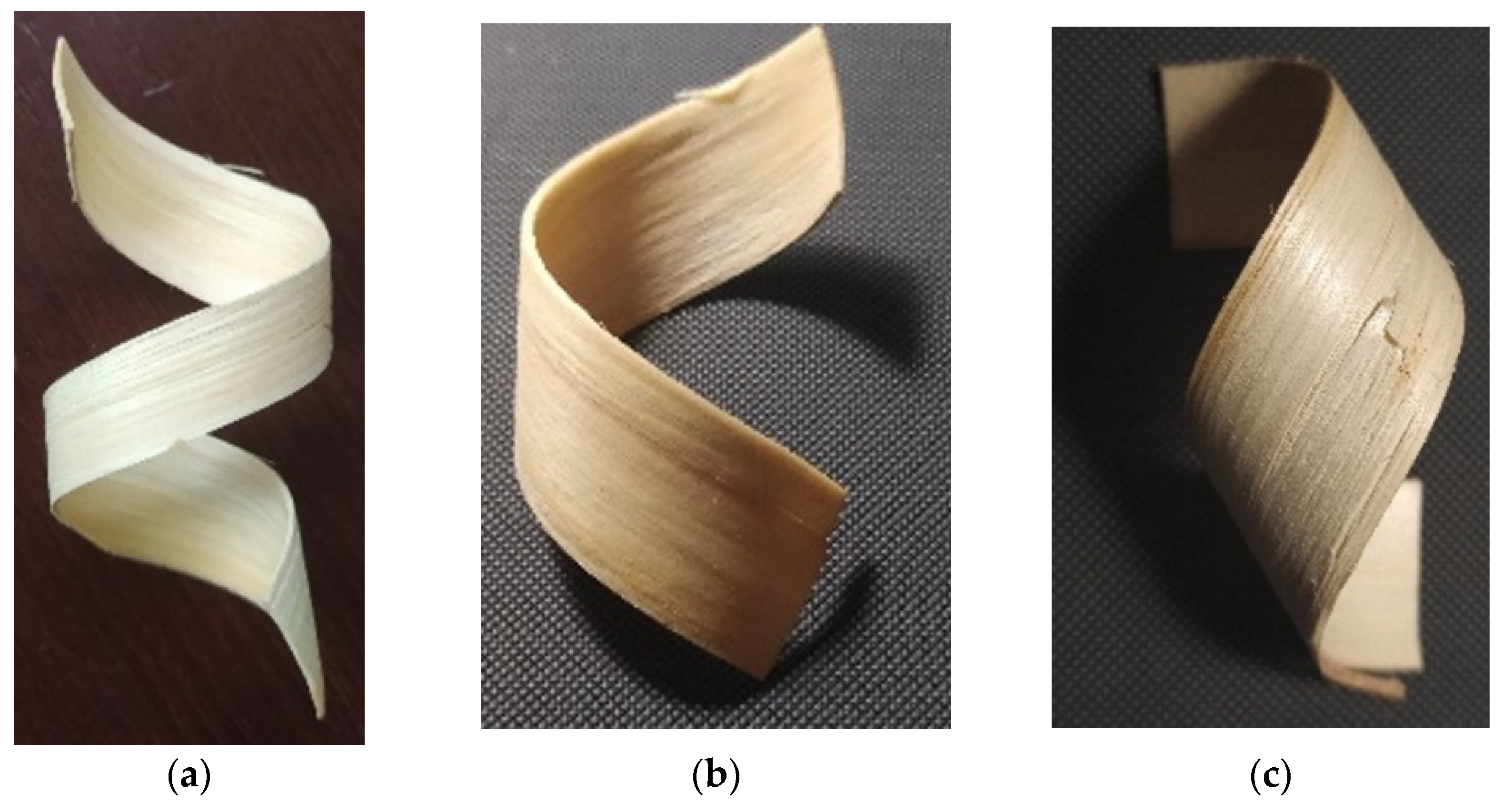

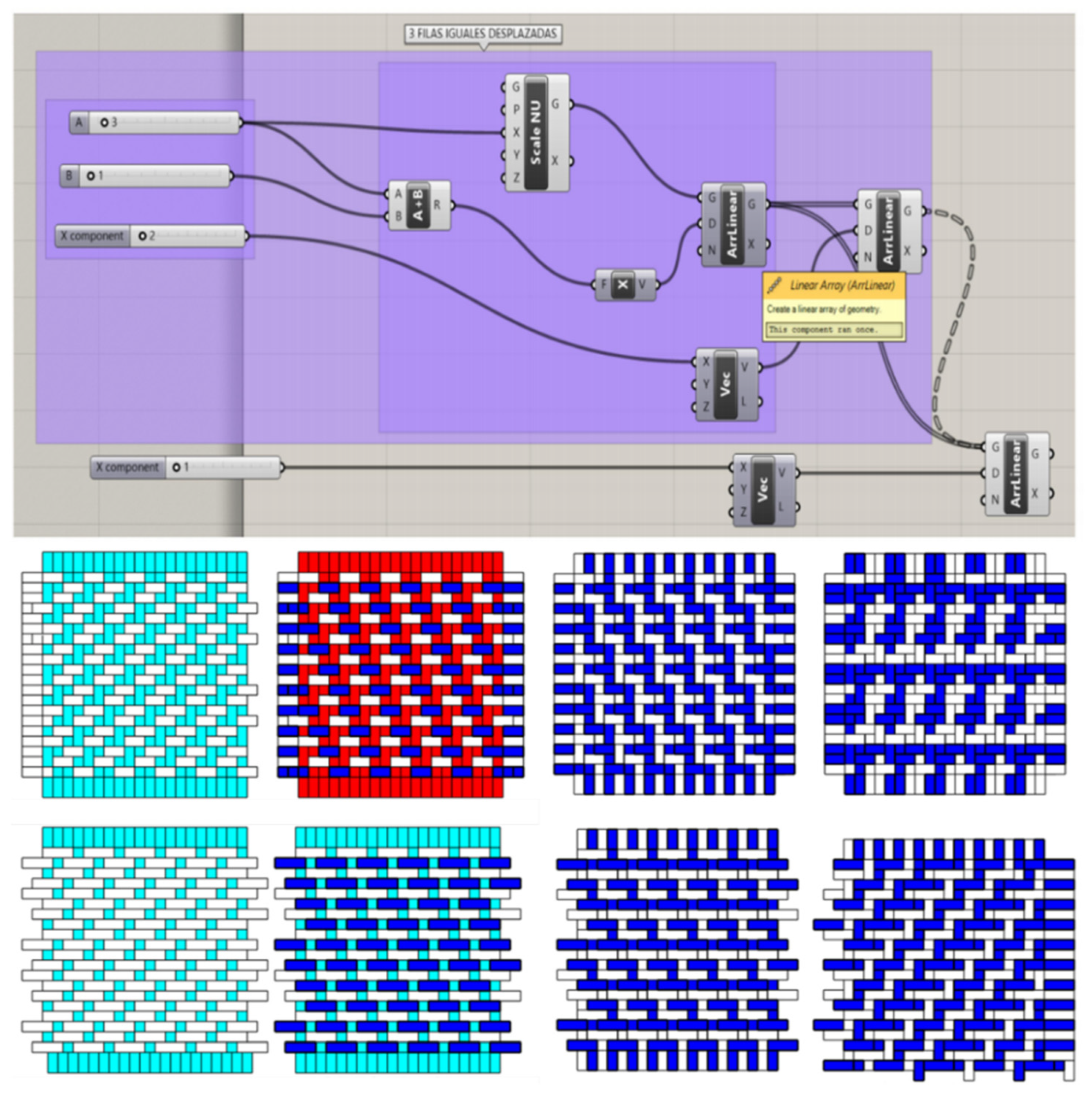


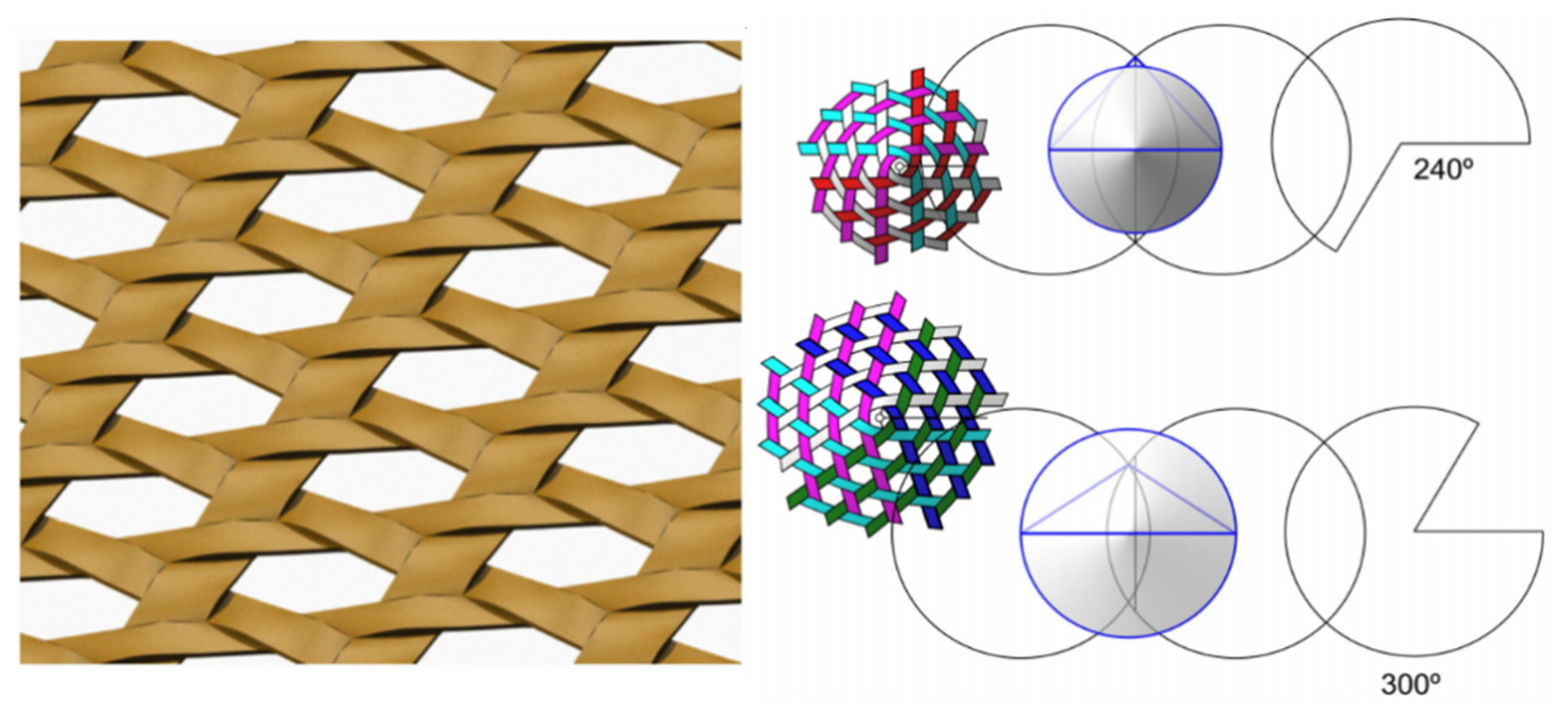
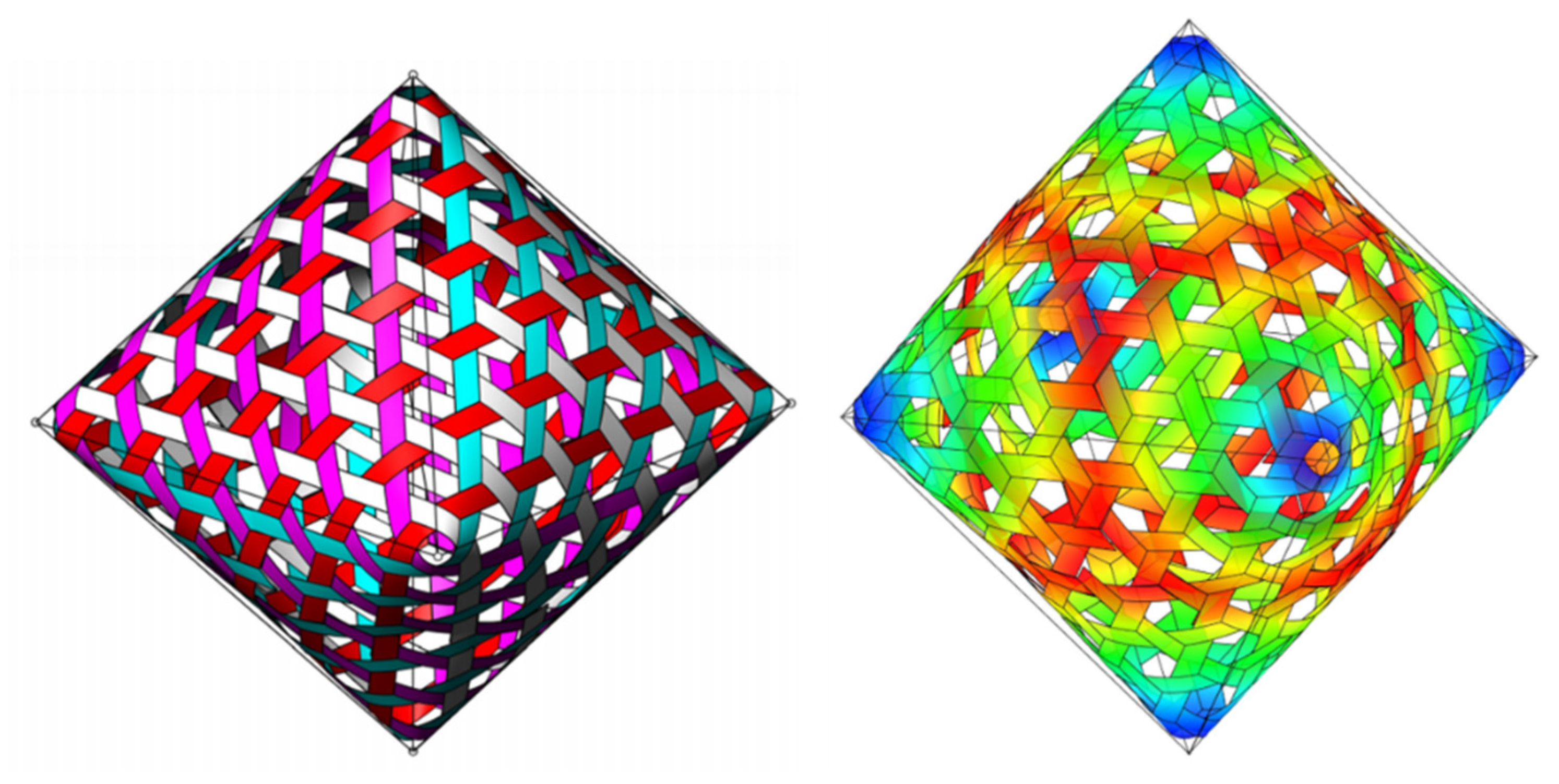

| Specimens | Young’s Modulus E (MPa) | Maximum Resistance σ (MPa) | Deformation at Break εz (%) |
|---|---|---|---|
| NS | 7096 ± 167 | 46.47 ± 5.85 | 0.73 ± 0.12 |
| 89.14 ± 7.81 | 2.11 ± 0.73 | ||
| MC | 7738 ± 605 | 51.20 ± 5.56 | 0.87 ± 0.17 |
| 79.29 ± 4.02 | 1.24 ± 0.15 | ||
| NC | 8740 ± 189 | 52.87 ± 5.90 | 1.17 ± 0.12 |
| 83.71 ± 3.19 | 1.66 ± 0.11 |
Publisher’s Note: MDPI stays neutral with regard to jurisdictional claims in published maps and institutional affiliations. |
© 2021 by the authors. Licensee MDPI, Basel, Switzerland. This article is an open access article distributed under the terms and conditions of the Creative Commons Attribution (CC BY) license (https://creativecommons.org/licenses/by/4.0/).
Share and Cite
Casado, A.; Sánchez, A.; Marieta, C.; Leon, I. Use of Flat Interwoven Wooden Strips in Architecture and Construction. Simulation and Optimization Using 3D Digital Models. Sustainability 2021, 13, 6383. https://doi.org/10.3390/su13116383
Casado A, Sánchez A, Marieta C, Leon I. Use of Flat Interwoven Wooden Strips in Architecture and Construction. Simulation and Optimization Using 3D Digital Models. Sustainability. 2021; 13(11):6383. https://doi.org/10.3390/su13116383
Chicago/Turabian StyleCasado, Amaia, Antonio Sánchez, Cristina Marieta, and Iñigo Leon. 2021. "Use of Flat Interwoven Wooden Strips in Architecture and Construction. Simulation and Optimization Using 3D Digital Models" Sustainability 13, no. 11: 6383. https://doi.org/10.3390/su13116383
APA StyleCasado, A., Sánchez, A., Marieta, C., & Leon, I. (2021). Use of Flat Interwoven Wooden Strips in Architecture and Construction. Simulation and Optimization Using 3D Digital Models. Sustainability, 13(11), 6383. https://doi.org/10.3390/su13116383






